

The Armley Schulze - speaking English with a German accent!
2017-05-23 - Sample Set Spotlight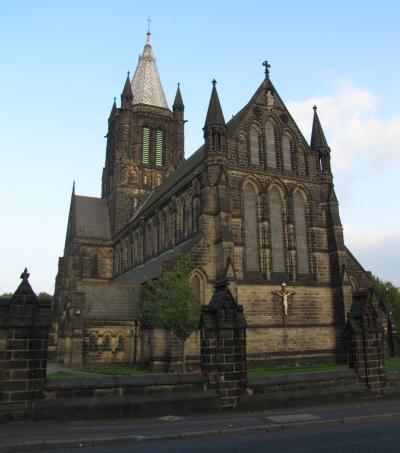
St. Bartholomew's Church, Armley, Leeds, built in 1872.
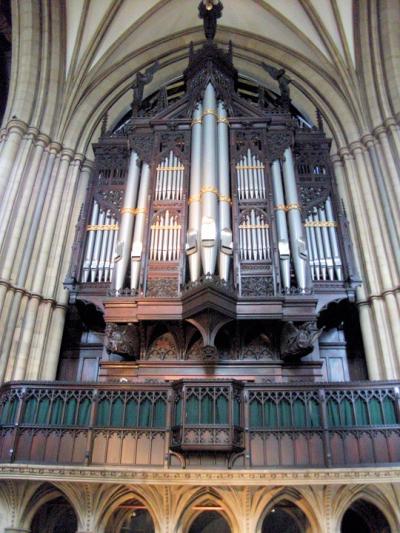
Standing in the Choir and looking up and North at the great Schulze organ case.
Anyone who has ever been part of a pipe organ installation knows that it is a big deal! A VERY BIG deal!
Organs are designed specifically for a certain space. Everything is custom made to fit exactly as it should in a place of a specific size and shape. If the organ is "too big," it won't properly fill the "organ chamber," and it will need to be "corrected," which often means ruined! Even if the builders can make it fit, it may be so cramped that it won't speak properly!
Several years ago, I worked for a large and famous church that had a very well-known instrument installed. It had suffered some neglect, but fortunately, had not been destroyed over the years. The problem was that this church did everything for the cheapest cost, and even from the day that the organ had been installed in 1909, errors had been made. The builders had "guessed" at some of the dimensions, and when they got the instrument there, it was discovered that it was too large for the space, and some of the largest pipes had to be mitered (bent). The 32' Open Wood had to be placed on both sides of one of the chamber's dividing walls. The result was that those pipes on the "right/north" side of the wall spoke more powerfully than those on the "left/south" side. With a situation like this, there is nothing that can be done, other than to pull it all apart and "build" it a second time! NOT a good solution!
My point of mentioning all of this is that any great organ must be carefully and specifically designed for the size, space, and acoustics of the church where it will live. Anything else will result in a disaster, or at best, an unsatisfactory installation and situation!
Or maybe not...

The Church from the Northeast.
The magnificent Schultze organ of St. Bartholomew's Church, Armley, Leeds, England, was NOT built for this church! It came to St. Bartholomew's from St. Peter's Church in Harrogate - another church that it was NOT built for! In fact, this splendid instrument wasn't built for ANY church! Instead, it had been designed in built as a home organ! To even imagine such a thing in today's world is beyond our comprehension, but that is in truth the way this organ began its life!
Before we look at the organ's travelling story, let's take more of a look at the Schultze firm, so we have some background to understand the history and tradition of the Schultze family of organ builders.
At this point, it is essential that I mention the fact that for the next few sections of this article, most of the information given about the history of the organ, the Schultze firm, and technical issues dealing with the instrument are almost entirely the words of David Butcher, the founder of Lavender Audio, and creator of this sample set. His descriptions are so complete and beautifully presented that it would be foolish to try to "improve" them, as this could not be done!
After the history and technical issues are dealt with, I'll "return" to my own words, observations, and musical examples and illustrations. For now, David Butcher's words will speak brilliantly to us!
The work of the Schulze dynasty dates back to the time of J.S. Bach; however the fourth generation of this family, Johann Friedrich - is usually regarded as the first with international significance. His meeting with Weimar organist Johann Gottlob Töpfer in 1824 was highly formative, setting a course for the future sound of the Schulze organ. Töpfer's work on pipe scaling had become hugely influential to the organ builders of the 19th century and the importance he attached to foundation stops, strings and increasing wind pressures all represented a move away from established practices of the era.
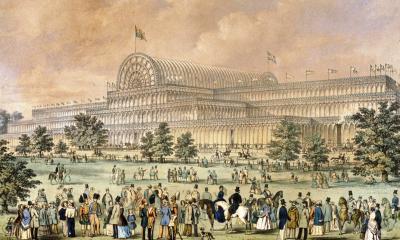
A painting of the Crystal Palace Exhibition.
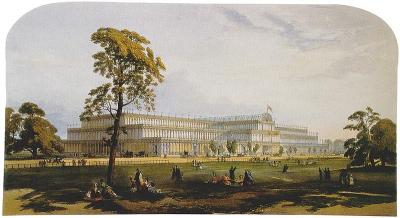
Another view of the great Crystal Palace.
Schulze's introduction to Great Britain came by personal invitation of Prince Albert in 1851 at the time of the Great Exhibition in Crystal Palace, London. The instrument exhibited there, although small, was noted for its excellent construction, warm but powerful chorus, not to mention new stops such as the Lieblich Gedact which were introduced to a British audience for the first time. This, along with the German company's newly found royal patronage, gradually caused the name of Schulze to become known across the United Kingdom, resulting in a variety of new commissions.
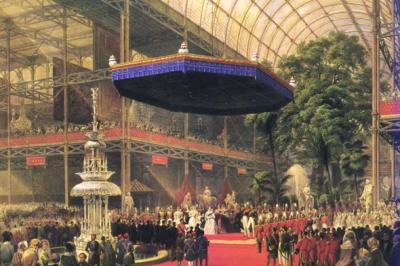
Queen Victoria opening the Crystal Palace Exhibition in 1851.
By now, J.F.'s eldest son Edmund was supervising most of the work - it was he who had exhibited the Crystal Palace organ and he was responsible for noted instruments such as those at Doncaster and Tyne Dock, built in the early 1860s. In doing so, Edmund built relationships with the organ building trade in England - most of the Doncaster pipes were supplied by Edward Violette of London, a firm subsequently bought by Charles Brindley. Brindley himself provided a temporary instrument to Doncaster whilst the work was carried out on the new organ there and he ended up supplying pipework to Edmund Schulze in almost all of his other English commissions - with just one exception.
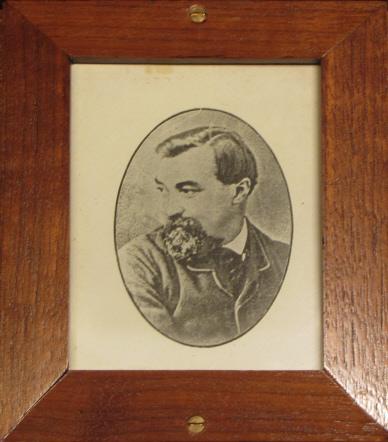
Portrait of Edmund Schulze, placed at the top of the organ console at St. Bartholomew's Church.
This is indeed where the Armley Schulze enters the story, although this organ was originally built for a very different environment ... a chalet styled wooden structure with seating for some 600 people. This so-called "Organ Room" was the brain child of Leeds-based engineer, mountain climber and organ aficionado Thomas Kennedy, whose wife Clara was an accomplished organist. The organ room was to be a part of the couple's newly built home, Meanwood Towers, a neo-gothic edifice designed by Edward Welby Pugin. History records initial correspondence between Kennedy and Schulze dating from 1866 where a sum of £500 is quoted for a two manual organ of 16 stops. Over the coming months, Kennedy continually changed the design brief and the specification eventually grew to four manuals and 55 stops. Schulze was further disadvantaged by a lack of knowledge of the dimensions of the new room, resulting in an overall delay to the completion of the project. Finally, in 1869, at a cost of £1800, the organ was installed and received a private opening recital given by Samuel Sebastian Wesley.
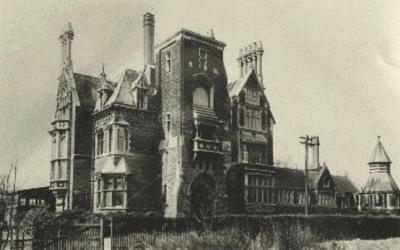
Meanwood Towers - the first home of the mighty Schulze in 1869.
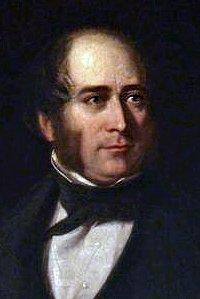
Samuel Sebastian Wesley (1810-1876) played the first (private) dedication recital.
Sadly, some 8 years later Clara's health deteriorated and the organ was put up for sale. Two wealthy sisters from nearby Harrogate snapped up the instrument and presented it on loan to their newly completed local church of St. Peter. The move was carried out by Edmund Schulze and Charles Brindley (now as part of Brindley and Foster) - they must have thought this would be the organ's final resting place. However, a disagreement with the rector a year or so later resulted in the organ being placed back on the market again.
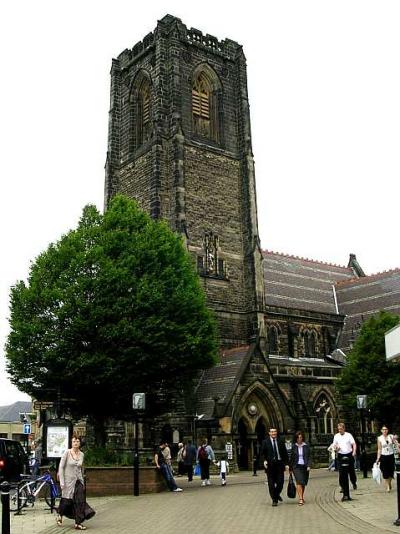
The busy parish Church of St. Peter in Harrogate. The second home of the Schulze organ.
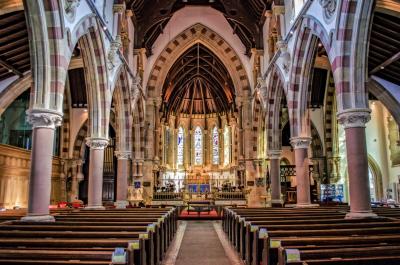
The colorful interior of St. Peter's Church, Harrogate as it is today.
This time, a wealthy Leeds textile manufacturer by the name of William Henry Eyres purchased the organ and presented it to St Bartholomew, Armley in gratitude for his marriage celebrations there. By now, Edmund had died, so this final move in 1879 was carried out by his brother Eduard alongside the ever-present Brindley. The opportunity was taken to further expand the instrument with the Open Metal 16' which form the display pipes and a full-length open wood Subbass 32'. A year later, in 1880, the Schulze firm was wound up, having greatly influenced the romantic organs of both Germany and England.
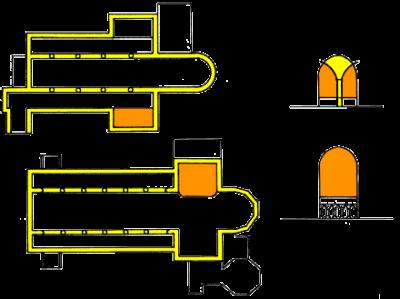
Comparative floor plans of St. Peter's Church (top) and St. Bartholomew's (bottom).
The final resting place for this wonderful piece of musical craftsmanship is an appropriate one - the organ was simply too loud for the Harrogate church, whereas Armley has sufficient space for both the pipes and their attendant powerful sound. In 1900, during cleaning, one small tonal alteration was made, probably by the Leeds firm of Abbott and Smith. The Swell Rohr Flöte was replaced by a Celeste, although the drawstop legend was left unchanged (it remains so to this day). Then, in 1905, a major restoration was carried out by James Jepson Binns. The ailing pneumatic lever action was replaced by Binns' own solidly reliable tubular pneumatic system and he also provided a new console in walnut. Binns was a huge admirer of Schulze (he tuned the instrument during its time at Meanwood), so it is certain that the overall tonal scheme as well as winding and slider soundboards were left untouched. However, as well as provision of his patent combination action, tremulants and a balanced swell pedal, it is known that Binns did raise the pitch from around C = 517Hz to 528Hz. At the same time, some of the reed tongues were weighted. The organ saw out the rest of the 20th century largely as left by Binns, with only relatively minor work such as cleaning, overhaul, wind trunking replacement and a new electric combination action being carried out.
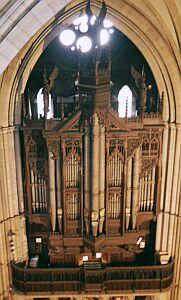
Peeking down at the Schulze organ and console from a window on the South side.
Then, in 2004, an historically informed restoration was carried out by Harrison and Harrison of Durham. They sought to return the organ to its 1905 condition by preserving most of Binns' good work. However, it was deemed important to return the organ pipe work to the condition left by Schulze, so reed loading was removed and resonators lengthened. The Choir and Echo pipework was moved to be at the same level as the Great, whilst the Swell was raised above the Great. Finally, Harrisons installed a modern solid state combination system, discretely tucked in a hidden drawer to one side of the keyboards.
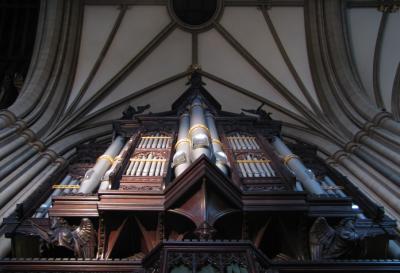
Standing directly under the organ and looking up.
Although the organ was built for a privately owned timber structure, Edmund Schulze must have suspected that the instrument would eventually find its way to a church environment. The scaling and power of some of the stops suggest as much and - in Armley - the acoustic approaches that of a small Cathedral. Indeed, although the reverb time is just in excess of 3 seconds, St Bartholomew's Church is a very resonant building, resulting in a significant component of reverberated sound being present even in recordings taken close to the pipework. The organ is situated in the chancel area, high on the north side and its power is very keenly felt in this part of the church. Further west, the power and brilliance is tamed (the famous five rank Great Mixtur becomes less strident) and the church's resonance increasingly affects the organ's sound, as would be expected.
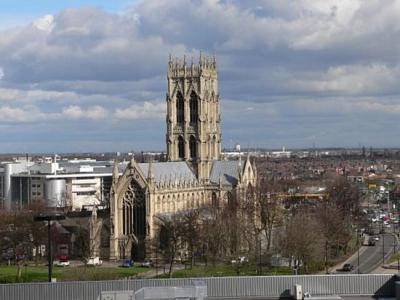
St. George's Church, Doncaster (Doncaster Minster), home of the famous 5-manual Schulze.

The console at Doncaster.
Before we get down to the particulars of the organ's unique and marvelous sounds, let's spend a little more time learning about the Schulze family of organ builders. I confess that other than knowing their work on this organ, the one at St. Peter's in Harrogate, and their largest and most famous organ at St. George's Church in Doncaster (Doncaster Minster), I really don't know all that much about them, so, we can "learn together" about them!

A map showing the location of the Schulze home and shops.
It is appropriate that the Schulze family shared the Thuringia area of Germany with Johann Sebastian Bach, missing out on being contemporaries by no more than a whisker. J.S.B. died in 1750, while Johann Andreas Schulze was born three years later, and become a renowned organ builder in the area. He was succeeded by his son, Johann Friedrich in 1806. It seems that J.F.S. took the art he had inherited and expanded the horizons by studying acoustics, and associating with Gottlob Tõpfer, professor of music and organist of Weimar, a position not exactly unknown by Bach himself. J.F.Schulze moved from Milbitz to the neighbouring village of Paulinzelle, (now Paulinzella) in 1826, where he set up house and workshops for what was becoming one of the most renowned organ building firms in Europe. He was well known by Prince Albert of Saxe-Coburg who was shortly to get his way to the British throne. It was natural that Albert, setting up his Great Industrial Exhibition of 1851 should think of Schulze when it came to providing an organ for Crystal Palace, after which the name Schulze became the musical flavour of the gentry, especially in Lancashire and Yorkshire, where the money and power was.
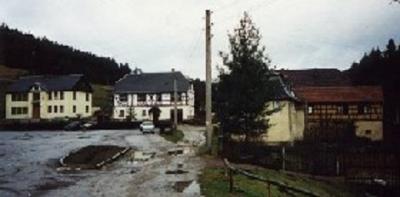
From left to right: the Schulze family home, the finishing shop, and the workshop.
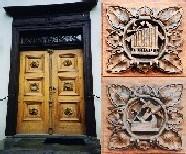
Carved door panels on the Schulze home.
Armley, in Leeds, is now described by the loaded term 'inner city'. From no more than a hamlet in the 18th Century, it had grown into a township of around 30,000 people by 1900. This came about purely through industrialisation, marked in Armley's case by many mills, some of which still exist, albeit dormant or serving some other purpose. In its day, towards the end of the 19th Century, Armley was a concentration of back-to-back terraces, with still enough whiff of the country to be home to a number of wealthy industrialists. Before long, these leaders of society were obliged to seek "better" and more "healthy" out-of-city areas, leaving behind a growing working class population and the embarrassment of abandoned manor houses.

St. Bartholomew's from the Northeast.

Ripon Cathedral from the Northeast.
For this reason, the Church of St.Bartholomew's now stands out above the clutter of modern streets and basic housing. It was the wealth and rivalry of the local notables which produced this cathedral-like edifice (in terms of internal volume it is the largest church in the whole of the Ripon and Leeds Diocese, not counting the cathedral at Ripon itself). Contemporary wealthy jostling adorned the Church with the extravagances of late-Victoriana, and the "High Church" adornments are very present in the building.
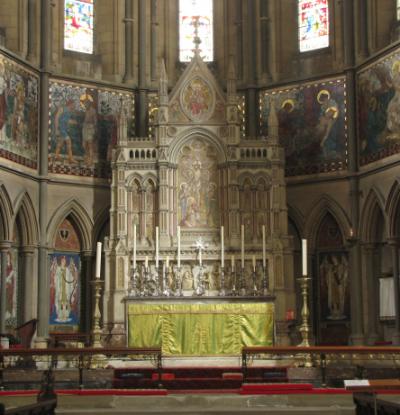
The High Altar of St. Barholomew's Church.
Now that we've taken a look at the Schulze firm and their work and influence, some photos of the home and shops, a brief look at the two previous homes of the instrument, Bentwood Towers, and St. Peter's Church in Harrogate, let's take a more in-depth view of the instrument in it's current and permanent location, St. Bartholomew's Church, Armley, Leeds. Before we do, let's spend a bit more time on the town of Armley itself.
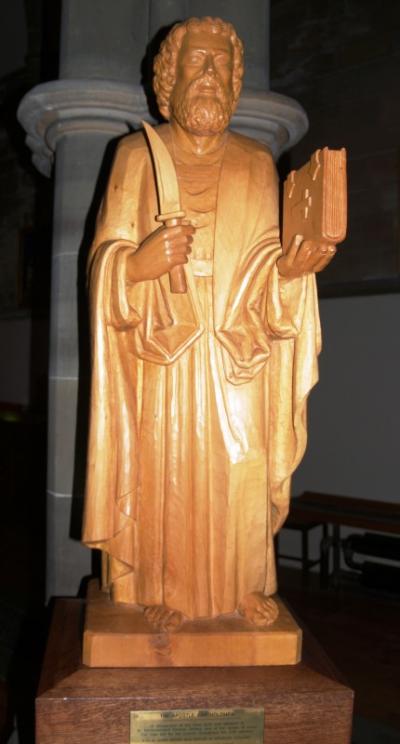
Statue of St. Bartholomew in the Church. He is always portrayed holding a large knife.
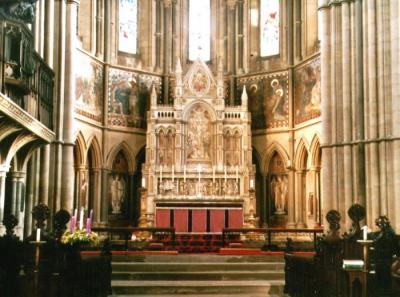
The Chancel of St. Bartholomew's. (Note the Advent Wreath on the left.)
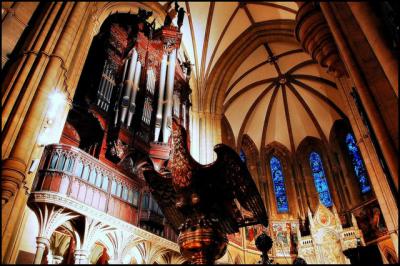
Below the eagle lectern (from the floor), looking up at the organ.
Armley, in common with many other places, if you try hard enough, can be traced back to pre-Domesday times, as the fortified settlement of a Danish chieftain. It really came into its own in the 18th Century, with the arrival of the woollen mills, with Armley Mills being at one time the largest woollen mill in the world. Later, Armley Mills was bought and augmented by Benjamin Gott, the main benefactor of the original church next to the present site of St.Bartholomew's.
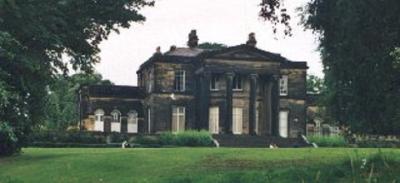
The mansion of Benjamin Gott, principle benefactor of the original church, built on a sight next to where the current church now stands.
From a position of localised wealth in the late 19th Century, Armley has fallen into the implied poverty which 'inner city' brings to mind. Certainly, no-where within its bounds is there the wherewithal to support unaided a Church the size of St. Bartholomew's or the particular appreciation of an inheritance such as the nationally unique Armley Schulze Organ.
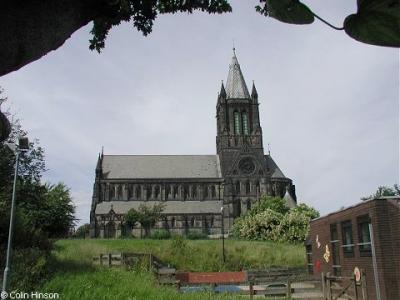
The church from the South, looking a little "out of place."
These words are cause of concern. They speak not only of the situation in Armley, but to the situation of many churches throughout the world. Buildings that were once mighty and filled with people, are now virtually empty and decaying. Stuctures that once housed glorious instruments, are now filled with the sounds of praise bands. In some cases the mighty instruments are still there, but some have not uttered a sound in years. Priests, if they even care, aren't even sure that the "old thing still works or not, as it's been about 25 years since the old man that played it died, and we never used it again, as the high school kid that we hired back then only played keyboards."
Religion and God don't seem so "important" to the modern world, certainly not as they did when a structure like St. Bartholomew's was built. I know an accomplished recitalist and recording artist who has expressed the opinion that, "This will all be gone in the next few decades! (Meaning the organ as the main instrument for churches, and even the fact that there will be churches still standing and open for business.) Sure, the "show place churches" will still be there, but the rest of all this will be nothing but a memory!"
I hope not...
Well, since we still have this masterpiece at hand and living, let's begin to take a look at it in detail!
The Armley Schulze Organ
When we look at the specification, we can immediately see that this is NOT an English organ - at least in the sense of the word that many of us think of. Most of us, myself included, would immediately think of the work of Willis, such as at Salisbury, Hereford, or Lincoln, or the work of Harrison at places such as Ripon, King's College, Cambridge, or perhaps even older large organs of Hill. Other important builders such as T. C. Lewis (1833-1915), whose work was influenced by Schulze, the instruments still "look more English" on paper, and do, admittedly sound more English, at least in terms of what most of us expect to hear.
The Schulze is a true Victorian survivor! While there are similarities to be sure between it and the "cathedral work" of firms like Willis, the differences between them, while not quite "massive," are still certainly significant.
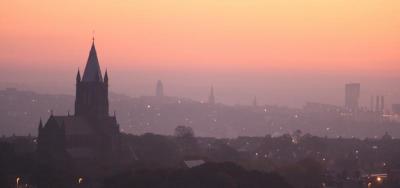
The church at sunset.
Let's begin by going through each division, starting with the Pedal. I'll make some fairly specific observations, and will try to illustrate my opinions with some of my recordings made upon the sample set. (Please note that for the musical examples, I use the "real" and not the "extended" version of the sample set.)
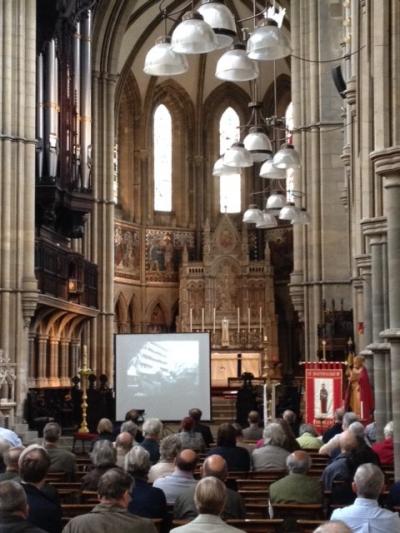
An organ recital in the church today, with a viewing screen for the audience.
PEDAL ORGAN
As previously noted, the full-length Sub Bass 32' was added after the organ arrived at its current home. It is impressive, but not over bearing. It seems to "purr" more than shake the floor, and can be with some degree of "versatility," meaning, it's not big enough to "drag down" a moving bass part. The Open Metal 16' is the heaviest and biggest stop, and adds the most bottom to the sound. It has more harmonic development than many such stops. Like all the diapasons on this organ, it has a bit more "string" to the sound than might be found on an "English" organ. The Principal Bass Wood 16' is "lighter" and less "boomy" than it would probably be on a big Willis. The Violon 16' has nice definition and color. It's slightly on the large side, but is wonderful under the right manual stops. The Sub Bass 16' is a rather typical pedal stop, but it also has some color to it, and does not drag. I often wished that this stop was little "heavier," but, it's probably correct as it is. The Quinte 10 2/3' "adds the fifth" to the 16', but with the 32' present, this stop will perhaps find "specific" uses. The Octave 8' has find definition, and goes perfectly with 16' Open Metal. The Violoncello 8' is independent (not an extension of the 16' Violon), and sings nicely. The Flöten Bass is independent, and seems a bit bigger than the 16'. It can "stick through" under very soft manual stops. The Octave 4' sits atop the 16' Open Metal and Octave 8', and makes an excellent, well-matched sound. The Posaune 16' is an excellent one. It's quite big (NOT massive), smooth, but with good color. It doesn't have the "thin fire" that a French pedal reed might have, but is probably more "harmonically developed" than many English pedal reeds. It's quite "orchestral" at times, but has grandeur and nobility. The Trompete 8' is a fine stop. It goes nicely with the 16', but is not terribly loud, as some reeds are. For instance, the Pedal at Salisbury has an 8' reed (Clarion, I think) which almost like a slightly-small Tuba! This is not that big by any means. The entire Pedal division is full and majestic, but you may find it lacks a little bit of "cutting through" if your using the full organ. Yes, it would be nice to have a 32' Bombarde, but since the real organ doesn't have one, it really doesn't interest me. However, the one that David Butcher has "extended" DOES work VERY nicely, and doesn't stick out or sound fake!
Here is a recording of Variations on 'O Sanctissima' by William Georg Epworth. It demonstrates many of the organ's colors, including a "pedal variation" at the end. Despite the splendor, you may agree that the pedal doesn't "get through" as much as we would like!
https://www.contrebombarde.com/concerthall/music/25441
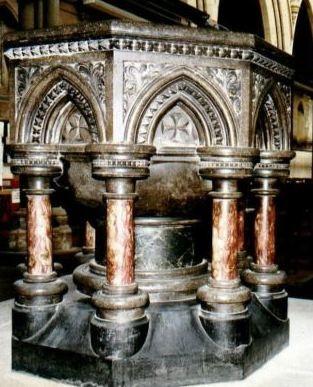
The elaborately ornate Pulpit.
CHOIR ORGAN
The Lieblich Bordun 16' is a nice stop. It's get some presence to it, and good harmonic development, but is neither nasal nor obnoxious in any way! As David Butcher has pointed out, it was Schultze that introduced the Lieblich Flute to England, and all of the so-named stops on this organ are very nice, and each is completely independent. The Minor Principal 8' is a pretty sound. It has a slight "stringy presence," but may be the most diapason-like on the whole organ. It is also a versatile stop, although it probably lacks a tiny bit of scale for underpinning the division. However, in most ways, it's exactly right! The Cello und Violone 8' is really quite an amazing creation. It's designed to speak as if it were actually being bowed! This idea works better on some notes than on others. Some notes "bow," others have a "unique, soft metallic chiff," while others have nothing really noticeable about them. It was the special sound of this stop that inspired me to do Gondoliera by Josef Rheinberger. The Harmonica 8' is soft and sweet, and would properly be called a Dulciana on most English organs. It's small, but does make it's presence felt if combined with other soft stops in the division. The Orchester Flöte 8', is a sort of harmonic flute. It's smooth and velvety with a "realistic" sound to it. I think that many English organs would call this a Concert Flute. I suppose you could call it a Clarabella, but somehow it seems "too gentle" to be called that. The Lieblich Gedact 8' is about as perfect as it can be. The Lieblich Flöte 4' goes with the Gedact. It's sparkly, fairly "big" and fully independent. The Piccolo 4' goes with the Orchester Flöte. It's smaller than the Lieblich, and smoother as well. although the ENTIRE division is very smooth. The Cornett II-V fachs is designed to go WITH the Lieblich Bordun 16' ON! ALL the mixtures on this organ require that a manual 16' stop/s is/are drawn! I found that if you draw the 16' stop, a combination of 8' & 4' stops with the Cornett, you can get a really excellent sound for Stanley Voluntaries - but you MUST remember to play the part an octave higher! The Clarinette 8' is rich, smooth, colorful, but still fairly dark. It's not as "beautiful" as a stop such as the Clarinet 8' on the Solo division of Salisbury, but a stop that I really like. It can be used in many ways, even as part of the chorus. It doesn't really have the "honk" necessary to play Couperin, but I suppose you could find a way!
Here is a piece that shows the Clarinette to good effect. I describe how I "imply" that the division is under expression by allowing the Swell to give the impression that you hear dynamic variance.
Andante religioso, Op. 14 - Patrik Vretblad
https://www.contrebombarde.com/concerthall/music/25561
The whole division, if drawn together, will make an impact, either alone or with the Swell coupled to it. There were times when I wanted a bigger sound from the 8' & 4' stops combined, but in terms of things "going together properly," you really couldn't want more.
(The Tremulant was added to the Choir in 1905. It has a charming old-fashioned sound to it, and suits the organ very well.)
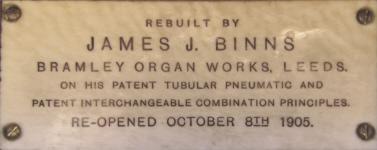
The plaque placed on the organ by the Binns Organ Company at the time of their work in 1905.
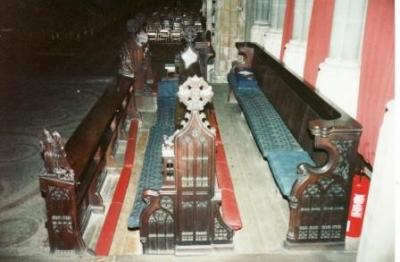
The Southside of the Choir Stalls. The organ is directly above.
GREAT ORGAN
As we would expect, we really come to the backbone when we come to the Great. It's a grand division, solid, romantic, and expressive. It gives the organ it's "heroic" character, and is in itself a wonderful sound. The Sub Principal 16' starts things off in the right way. Don't be fooled by the words "Sub Principal," as they tend to make you think of something heavy and lumpy! This stop provides the grand "floor plan" that the entire division rests upon, and is essential. The Bordun 16' is fairly big, but balanced. I think that it may be a little "larger" than the Pedal Sub Bass 16', but that's probably an illusion. It gives you the option of have a somewhat softer 16' stop (as opposed to the Sub Principal), but really doesn't support the Mixture with enough bottom. The Major Diapason 8' is a rare kind of stop. It provides "diapason support," but once again, has much more "string influence," allowing it to sing as a solo stop. Now, any excellent English diapason can do this too, but this principal allows itself to go into the higher registers, with the colors of the string, but without harshness or scratchiness, as you can hear in this Andante by Otto Dienel:
https://www.contrebombarde.com/concerthall/music/25440
The Gemshorn 8' is an outstanding example of this type of stop. It is smooth and full, but not loud or harsh. However, it is not just an indifferent 8' stop, as one often finds. It blends extremely well with the Gedact 8', which is articulate and refined, but with a sense of shape and color about it. The Hohl Flöte 8' is one of the true delights of this organ! It is emotional and singing. It is exquisite as a solo stop, and can be used in chords, or with any other combination of 8' stops on the Great. On a "real" English organ this would be called a Clarabella. It worked well in every way that I used it, and I used it in a LOT of different ways! The Octave 4' is a gem. It sits perfectly on top of the 8' Major Principal, but can be used with other 8' stops as well. It could even be used to reinforce a trumpet line. It makes it's presence known, but does not dominate the ensemble. The Hohl Flöte 4' is quite large and cheerful. It's a very fine sound, and, like all the stops on this organ, is completely independent and not an extension of the 8'. The Rausch Quinte 2 fachs is somewhat "controversial" I suppose. All it is a single stop that combines principal pitches at 2 2/3' and 2'. On English organs, these would be called the Twelfth and the Fifteenth. Why did Schultze "combine" the two ranks, and not give the player the option of using them separately? I don't know. I suppose this is just the way he wanted to build it! From what I know, I think it would have been pretty much "common practice" to draw the two stops together in 19th-century German literature. I don't know. For my own preferred usage, I often (usually) use the Twelfth with the Fifteenth, so, it actually made it "easier" to only draw the one stop! (I'm sure the extended version allows the separation of the two stops.) As one who thrives on realism, I just accepted the fact that the two ranks are drawn together, and got on with it! I can truthfully say that I never once missed the ability to "divide" them. So, at last, we come to THE famous mixture! Yes, the Mixture V-fachs is a BIG one, but it crowns the entire instrument in a way that is both spectacular and solid. The mixture has a surprising "glitter" to it. I don't know if it's the way that it breaks, but while I do find the mixture loud, I never found it to be overbearing. I would state that this mixture will be the LAST STOP to be brought on! When using this mixture, you MUST draw the 16' Sub Principal - to complete the chorus and avoid "funny notes," but just to provide enough bottom for it to rest on. Here is Bach's Christ lag in Todesbanden, BWV 625, as an example of the full Great chorus, uncoupled, with the principals drawn at 16', 8', 4', the Rausch Quinte and the Mixture.
https://www.contrebombarde.com/concerthall/music/25367
Finally we come to the Great reeds, and great is indeed what they are! The Tuba 16' is not we think of as an English tuba, so, don't expect to toot fanfares with it! Rather, I'd call it "trombone-like," grand and smooth, softer than the 8' reed, but just the amount of sound that you need. It does not dominate, and will not fight with the 8' for leadership. The Trompete 8' is another perfect stop. It shows different facets of its personality depending on the way you use it. It can be "tromba-like," it can speak as an English solo trumpet, or it can be used as an almost-full organ topper. The sound with everything on, except the Great Mixture and 16' Tuba, will really "arrive" when you add the Trompete 8'! It is a very heroic stop, and, I honestly think is one of THE best Great trumpets I have heard or played! However you use the Great, you will find elegance, refinement, beauty, excitement and power! The possibilities are tremendous, and the sound does weary or ever become stale!
Here is Allegro marziale from Three Short Pieces by Everett Titcomb. This piece really shows the Great reeds (and everything else!) at its heroic best!
https://www.contrebombarde.com/concerthall/music/25341
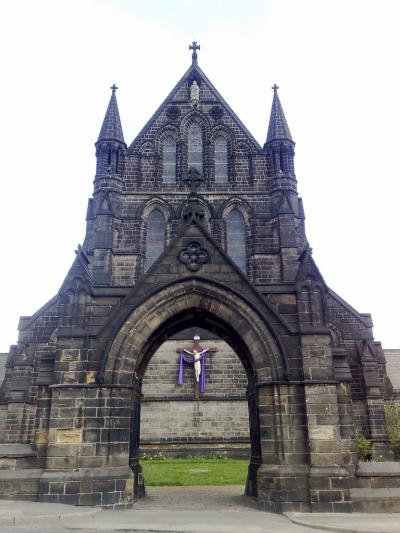
The Lychgate is an gateway with a roof placed at the entrance to a traditional English churchyard.
SWELL ORGAN
Like all the manual divisions of this instrument, this division is based upon a 16' stop, necessary to "ground" the mixture. The Bordun 16' is a substantial stop. It's not big or heavy, but it's solid. If you look at organs like Hereford or Salisbury, you'll see that the Willis firm often preferred something like a 16' Gamba, rather than the usual Bourdon. The intent was that the string was more versatile than the flute, and less "thick" in textures. While this is so, on this organ, the Bordun IS the right stop. The Geigen Principal 8' is the diapason of the division, and works in an ideal manner. It sings well, and because of it's geigen/string leaning, has more harmonic development than the usual English Open Diapason. The Gamba 8' is also quite substantial, but in a mannered way, and can add color and texture to the ensemble. When I keep referring to the "stringed influence" of this organ, notice how this is so, since the Swell has 2 8' strings! (3, if you count the celeste.) The Salicional 8' is smaller than the Gamba, but not inconsequential. The famous Celeste 8' is actually drawn by Schultze's original "Rohr Flöte" stop knob. This alteration was probably done by the Leeds firm of Abbott & Smith, and I think it is universally accepted as an excellent change. Like many (most) celeste stops, it only extends down to "tenor c." The Flauto traverse 8' is a very smooth stop. It certainly gives a different sound than the more usually Lieblich Gedackt would give, but it's a very happy difference. The Octave 4' sits perfectly on top of the 8' Geigen. It sings and adds brightness at the perfect level of sound. It "slides" easily on and off, and does not make a big screech when it comes on, or a dull hole when it goes off. The Flauto Traverso 4' is colorful and sweet, and goes beautifully with the strings and 8' flute. It is an independent stop, and not a unified extension of the 8'. There is no 2' stop on the real organ. The extended version of the sample set has one, but to be honest, I never missed its absence! The Cymbal IV fachs is an unusual stop. It's quite bright, and your first impression is: "This is too much! It's going to stand out!" - but it doesn't! It really adds the needed amount of sparkle to the full division, but it does not dominate it. After using it for 30 seconds, you'll feel it's the perfect mixture for the Swell. Granted, it does have some "problematic" breaks, but these are all part of this type of organ and the sounds that it produces. (On the extended version, you can "correct these mistakes," by using Alternate Voicing 2 - but why would you want to?!?) The Horn 8' is a full-toned trumpet. Maybe even a Cornopean-like, but probably a little too colorful for that! It works as either chorus reed or solo, and can even be used with the Tremulant. By "Horn" do not think that it is a French horn or a Waldhorn, or any other kind of horn. Whatever the definition, it's superb. The Oboe 8' is also a gem. It probably has a little more brightness than a pure English oboe, but it certainly is not French. Here again, it does double duty as a solo or a chorus reed. Any player of English organ music will tell you that an English Swell MUST have a fine oboe as part of "the" sound, and this one certainly fills the bill. The Clarine 4' is quite bright, and does make an impact when you add it as the last stop to go onto the full Swell, but the effect is balanced and grand, and not "nervous" or "shrill." As a person who lives for the sound of the "full Swell," this one looks to fall short on paper. Had I not known the organ, I would be highly critical of the fact that there is no 16' reed. How can you have a proper full Swell without a 16' reed?!? How? Easy. By having THIS full Swell!
(Like the Choir, the Tremulant on the Swell was added in 1905. It's a little "slower" than the Choir Tremulant, and the effect, at least to me, is a bit more "refined."
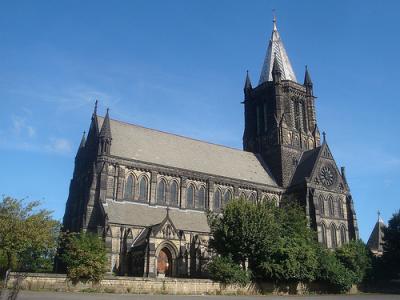
The church from the Southwest.
ECHO ORGAN
When most American organists see the words "Echo Organ," we immediately think of a massive 150 rank organ, with an echo division installed high in the roof and providing a nice home for bats or other creatures! It probably will contain number of string stops, a few flutes, and a soft Vox Humana, and except for very rare occasions, will be only useful to those that really now how to use the division, perhaps by playing orchestral transcriptions from the 1920's! It's just the way they used to build "echo organs" in the United States!
Well, this Echo Organ is not anything like that. Perhaps I should it's hardly anything like that, since it does have soft strings and flutes, but there are no excesses, and the "ethereal effects" are FAR less exaggerated on this organ. It is not even under expression! (Although I think it may be on the extended version.) The Tibia Major 16' is just a nice, neutral stop. It's not a theater organ kind of thing! The Vox Angelica 8' is a soft, but rich string, and it is designed to "make a celeste" with any and all stops on the Echo Organ. The Echo Oboe 8' is a very gentle reed (without the celeste) and more string like (with the celeste). It's a pretty sound. The Zart Flöte 8' is a soft open flute, and the Dolcan 8' is a very neutral stop - which could sound like a flute or a string. The Still Gedact 8' is a stopped flute, neutral, but with enough harmonic presence to be able to stand as a soft solo stop. Echo Flöte 4' is what the name implies, and goes nicely with the Still Gedact, or in other more "piquant" combinations. The Dolcissimo 4' is a soft, flutey-string, attractive and sweet. The Nasard 2 2/3' balances ideally with the other flutes and adds color. Note that it is the ONLY "mutation" on the entire organ. The Flautino 2' is soft and bright. By combining the flutes at 8', 4', 2 2/3', & 2', you can make a "mini-cornet" for yourself. In making my recordings, I found that I used the Echo Organ occasionally, and always with pleasing effect.
Here is the Chorale Prelude on 'St. Clement' by Alec Rowley. You'll hear some use of the Echo Organ in this one.
https://www.contrebombarde.com/concerthall/music/24751
(As with the Swell and Choir, the Tremulant was added in 1905.)
THE HAUPTWERK SCREENS and SAMPLE SET USAGE.
It has been pointed out to me that my Sample Set Spotlights concentrate too much on the real organs as opposed to the sample set. Well, it may seem like that, but it is of course the sample set sounds and usage that I have at hand and in mind! If it seems like I'm talking about the real thing, this must surely speak of the "realness and quality" of the virtual instrument so well-portrayed by the sample set!
Anyone knowing the work of Lavender Audio will be immediately aware of the highest-quality and top-notch work, not only of the sounds of their sample sets, but also the graphics that go with the sounds!
I admit that I'm not much for "playing around" with the graphics. I always use the "main console" window as my monitor home base. I do this because I look the way it looks, and the increased realism that I feel when using it. The fact that I have only the one monitor also determines my preference.
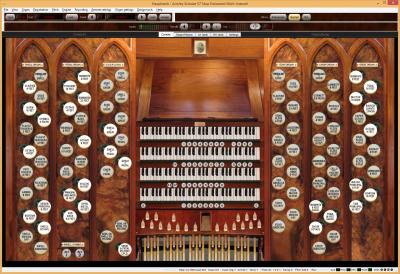
Hauptwerk main monitor screen showing the superb virtual console.
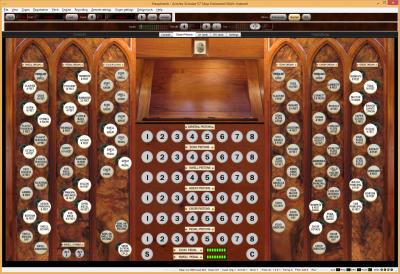
Another single monitor view, showing the stops, pistons, and swell box position.
If you have multiple monitors, than Lavender Audio certainly have "divided" screens to accommodate your more luxurious home set up.
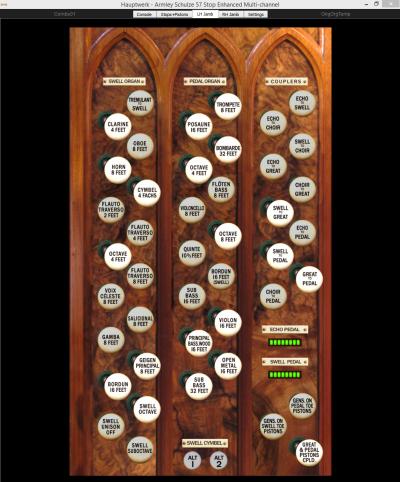
The left side jamb.
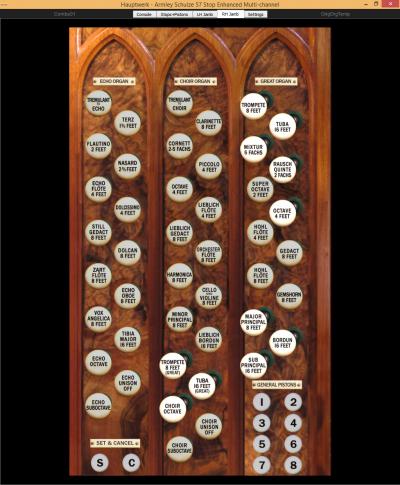
The right side jamb.
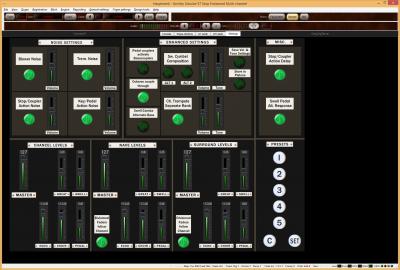
The Hauptwerk control screen, showing listening position and various noise control options.
All of these shots are from the extended version, which I do not use, however, the "real" version features all the same quality and versatilities.
In addition to the standard controls, you can also easily determine your preferred "listening position" by moving the sliders so that you are...

At the console...
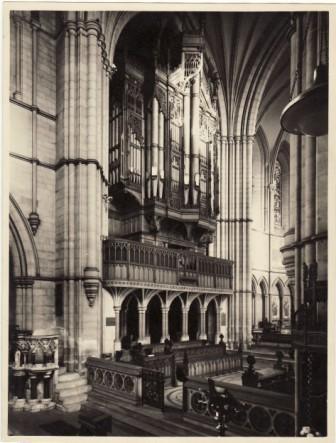
Just below the organ in the Chancel...
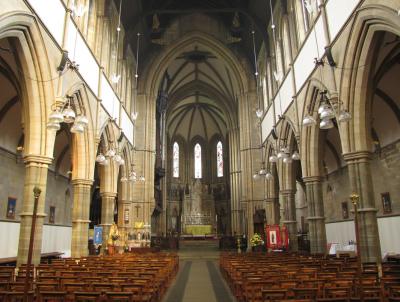
Further down the Nave...
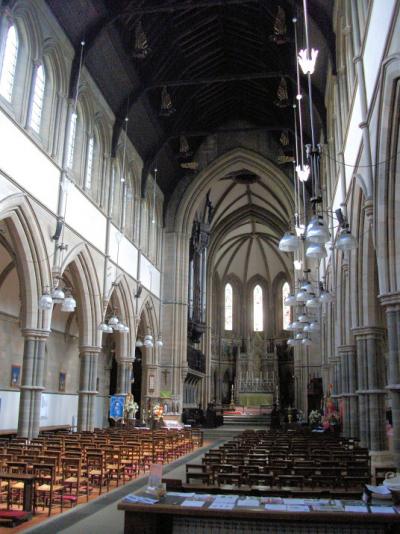
in the rear of the church...
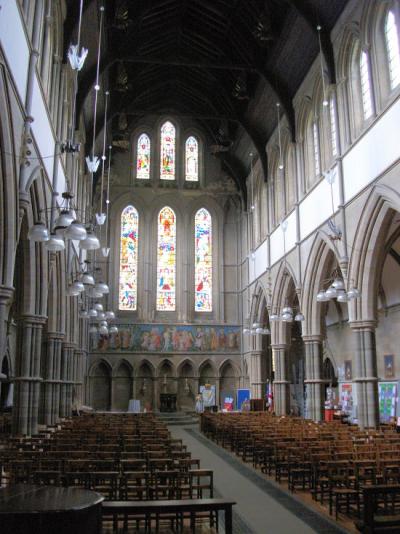
or in the rear with the organ behind you!
The Schulze as a "church organ".
As most organists, I can't help but often think of the organ as a "concert instrument." It's fun and exciting to see how many kinds of pieces a particular organ can play! Sometimes, we can play pieces in an "authentic" manner, while at other times, the work may sound great to us and our listeners, but really not have much "historically accurate" relationship to the type of organ that the composer wrote a particular piece for.
All that aside, for me, the single most important thing is: How will this (any) instrument function in its liturgical role? Will it be able to lead inspiring hymn singing? What about accompanying the choir? Can it play the service of the "particular tradition" beautifully and artistically? What about preludes and postludes? Well, that last one would fall under the "concert side," wouldn't it?
I think it's of utmost importance that the instrument "suit the worship" of the building in which it is placed. How does the Schulze measure up in this area?
This question is really what lead to my title about "speaking English with a German accent," since this "German organ" is going to have to able to play "English music.
In this area, I'd give the organ a high score. It handles hymns well, and in different styles. Here are a few examples:
Here is an not-pretentious Anglican hymn which works nicely. It's perhaps not quite as "smooth" as it might be on a Willis or Harrison, but pleasing none the less.
O joy of God, that comest in the morning - Sydney Watson
https://www.contrebombarde.com/concerthall/music/25284
Here is a great German chorale that I played in what I hoped would be a manner that showed the "various choruses" that the organ has. I deliberately did NOT play this in an Anglican style!
This is Christ the Lord is risen again - melody from Hundert Arien, Dresden 1694
https://www.contrebombarde.com/concerthall/music/25211
One final hymn - an Easter one, and a bit more on the grand scale! This one really sounds great, and many listeners liked it a lot, as did I! I did miss have a Solo Tuba in this one, and if YOU don't object to using the extended version, you CAN! For me, realism is the thing...
Christ the Lord is risen today- Joseph David Jones
https://www.contrebombarde.com/concerthall/music/25172
As an "accompaniment instrument," the Schultze would do an excellent job all around. Once again, it won't have the "smoothness" or "variety" that a "cathedral" organ will have. You'll have to make do with things like Solo Tubas, and you'll need to chose your stops carefully.
As a small demonstration, I did a recording of Thou wilt keep him in perfect peace, by S. S. Wesley. If you think back a few minutes, you may recall that it was Wesley who played the "first dedication recital" on the organ when it was installed in the private home of Meanwood Towers.
This classic anthem shows not only Wesley's skill and craftsmanship, but gives us a chance to hear the organ in the "Anglican sound of the period." Notice that it was then (and still is!) sounds like the diapasons and oboe that dominate.
https://www.contrebombarde.com/concerthall/music/25533
The Schultze has wonderful sounds and colors from which to select, and it again wins high marks for its liturgical work. However, if we listen carefully, we can hear moments when we hear English being played with a little bit of a German accent peaking through!
SOME THOUGHTS ON REGISTRATION
At this point I've made about 80 recordings with the Armley Shulze sample set. I also had the opportunity to play the real organ in the early 1980s, so, I feel that I know it pretty well. I've tried to use the recordings not only to show what I hope will be found to be interesting music, but to show just how much "neat stuff" can be done with this sample set.
For the sake of conciseness and usefulness, I'll group my comments/demos in 4 lists - German, English, French, and American to cover the four national-styles that I've played upon it.
German
The Schulze is an excellent "Rheinberger organ." It really handles this type of repertoire well, although you couldn't really call an "authentic" organ for the music, as Rheinberger had far less at his disposal, and did not even have a swell box.
Some examples I would call to your attention:
Vision (Twelve Characteristic Pieces), Op. 156, No. 5
https://www.contrebombarde.com/concerthall/music/25198
Here, you'll hear the Swell strings against the Great Trompete, used like "orchestral brass."
Gondoliera (my arrangement of a piano piece)
This features the Swell Oboe and tremulant, and shows some of the effects possible by combining the 8' foundation stops, as well as solo moments for stops such as the Great Gedact 8'.
https://www.contrebombarde.com/concerthall/music/25382
Canzonetta (Twelve Characteristic Pieces), Op. 156, No. 3
This shows the solo played upon the Swell Gamba 8' with tremulant. It is played without use of the Swell box as an experiment.
https://www.contrebombarde.com/concerthall/music/25529
Lamento (Twelve Characteristic Pieces), Op. 156, No. 9
This one really shows the "emotional feeling" of the Great 8' stops, with the Hohl Flöte dominating with wonderful effect.
https://www.contrebombarde.com/concerthall/music/25530
Passacaglia (Twelve Characteristic Pieces), Op. 156, No. 11
In this one you get the fullest Full Organ! It's intense, especially when recorded "up close" as this performance is. The Mixtur of the Great dominates it, and it's hard to clarity. Still, it's a mighty sound!
https://www.contrebombarde.com/concerthall/music/25531
Playing Baroque literature on the Schultze will challenge your creativity! I think that it can be done, and convincingly so, but you will have to be flexible and willing to adapt.
ALL the mixtures on this organ are based upon the 16-foot series, which means that you MUST draw a 16' manual stop/s when using the mixtures. The mixture also feature the "tierce-rank" in them - sort of like a "cornet mixed into the mixture," which I believe was pretty much the norm in German and English organs of the period.
Take a listen once again to Christ lag in todesbanden, BWV 625 from Bach's Orgel-Büchlein. The registration is detailed along with the upload.
https://www.contrebombarde.com/concerthall/music/25367
Finally, I'll call your attention to one more "German" upload, although with G. F. Handel, it's hard to know whether to call it English or German - sort of like the Schulze organ! This little Rigadoon is also "historically important" in terms of this organ, as it was Schulze who introduced the Lieblich stop to England. In this performance you'll hear the Great Gedact 8' (a Lieblich in its own right) for the forte, and the Lieblich 8' of the Choir for the "echo."
https://www.contrebombarde.com/concerthall/music/25250
I think we can score this very high on German music, but, how does it play French music? Let's take a look and a listen!
French
I admit that I found getting the "French sound" more of a challenge. I was able to get good sounds, even fine sounds, but I don't think that it's really a French sound. I'd call it a "19th century sound," but because of the class, quality, and nobility of the instrument, it works! Here are just a few examples:
One of the first uploads I did with this organ was the Entrée Pontificale by A. Vanden Plas. We know very little about the composer, and I admit that he is a Belgian, but the "Belgian School" and the "French School" are close, so, let's listen and pretend! The sound is very much in the French "grand choeur tradition," and while it's splendid and grand, it has that "19th century sound" that I mentioned above. It doesn't really sound French, but, who cares?!?
https://www.contrebombarde.com/concerthall/music/24786
Let's listen to a soft one - and a famous soft one at that - the Prière à Notre-Dame from Leon Boëllmann's famous Suite Gothique, dating from around 1925. For this I used both "sets" of Swell strings. For the first time through, it's the Gamba 8' along with the Celeste that you're hearing, and for the second time, it's the Salicional and the Celeste. The Gamba is more pungent, and probably more French. The Great Hohl Flöte and Gedact are heard prominently in this piece. If you've read this LONG article, you'll know how much I love the Hohl Flöte, but again, I'd say the sound is more "19th century," and it is Germanic. Pretty as it is, I don't think I'd identify this as "French." See what you think!
https://www.contrebombarde.com/concerthall/music/25466
One more from the Suite Gothique - the famous Menuet Gothique. At the risk of just repeating myself, I'll say that we again have the 19th century sound. The Mixturs are "too dominant" to make it sound French, but there's no doubt that it is a grand sound!
https://www.contrebombarde.com/concerthall/music/25465
I saw on a recent REAL recital on the Armley Schulze that the program featured the works of Louis Marchand and some other French Baroque works, and I was anxious to try some, but I figured that I'd NEVER get this review done if I didn't wrap it up and let those attempts happen at a later date!
My feeling about French music on this organ? YES, but you have to make it work and enjoy THIS sound, as opposed to laminating the fact that it doesn't sound like a Cavaillé-Coll!
So, let's move on to English items, and I will "pick and choose" from the bunch that I've done.
English
The organ is IN England, so, it MUST be able to play English music, correct?!? Not necessarily, but THIS one does, and VERY well too!
Let's start with a fun one - The Lord Mayor's Swan-Hopping Trumpet Tune, composed by that famous multi-national composer, Anonymous! In this one, I "incorrectly" dialogued the two trumpets, with the Trompete of the Great taking the forte and the Horn 8' of the Swell providing the piano. I think the "color" of these reeds are superb. While the Great one has "enough brass" to sound very convincing on this, it's also an excellent chorus reed that really rides along perfectly on top of the diapasons. The Swell Horn is also ideal in this, but also can have a more "dramatic" or even "soloistic" side. I DO wish the Choir Minor Diapason had a bit more "width" to make a little "fuller" bass, but, the organ shines in this one!
https://www.contrebombarde.com/concerthall/music/25252
You can't get a overview of English organ music without looking at the works of John Stanley. At first thought, doing a Stanley Voluntary on this organ seems difficult and problematic, and, to a degree it was, but I think the end results justify the "tricks" that you have to use - such as playing the "Cornet" an octave higher, and then remember to come "down the octave" when you change manuals! This piece also shows off the Swell Horn 8', which serves as fine Trumpet! If you listen you'll notice the somewhat "stringy sound" of the Great Major Principal 8' in the opening section - a giveaway that this really isn't an English organ! The registration "explanation" is given with the upload.
Voluntary in C, Op. 5, No. 1 - John Stanley
https://www.contrebombarde.com/concerthall/music/24850
Let's turn our eyes and ears to something softer and more modern - Pastorale by Sydney Watson (1903-1991). The way that this piece worked so naturally really pleased me. It took virtually "no figuring out," and I think the first stops that I tried were I exactly the ones that I used in the performance. The Great Hohl Flöte 8' features perfectly as the "solo" and the "chiff" and sound is really beautiful. The "lightness" of the Swell stops are also right on the mark in this piece.
https://www.contrebombarde.com/concerthall/music/25283
So, how can the Schulze handle the "cathedral-style"? Can you make it sound "like a Willis"? Well, the answer to those questions are: "yes" and "no". It can CERTAINLY handle the cathedral-style, and can "survive" a lot of "button pushing" (piston usage, particularly divisionals), resulting in a very grand effect. However, it's not going to have the same "thunder" as massive cathedral instrument, nor will it always permit "bridging" as smoothly as it might be. By "bridging" I mean, adding or subtracting stops. Since this organ has "fewer" stops, and some that are "missing" (like 2' stops or a 16' reed on the Swell, etc.), you have to be more creative and willing to take THIS wonderful sound as it is - rather than spend your time "wishing for a Willis!"
Here is Alec Rowley's Chorale Prelude on "Lasst uns erfreuen" to demonstrate my point:
https://www.contrebombarde.com/concerthall/music/25210
There are quite a few English uploads that I've done on the Concert Hall, but let's wrap-up our English section with two works by John Varley Roberts (1841-1920) who actually WAS organist of St. Bartholomew's Church - HOWEVER - he left before the current church was completed, and before THIS organ was installed!
The first of these shows the Schulze as a true "blending" organ. It's 19th-century English, as the Victorian cathedral sound is evident, but it still pays homage to Mendelssohn, so, the German accent as not at all out of place.
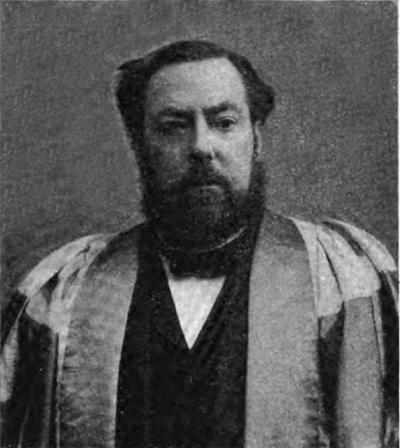
John Varley Roberts, an organist of St. Bartholomew's "original" Church.
Andante - John Varley Roberts
https://www.contrebombarde.com/concerthall/music/25427
Also by Roberts, his most "famous" piece, the Postlude in F. Once again, we hear a "blending" in this piece. It's English to be sure, but still shows a great influence of the French Grand Choeur Tradition, that composers like Guilmant made so popular. In my performance, your listening location is quite a bit to the rear of the church, and, as I said in my notes, "the old Schulze really 'rolls it' down the nave!"
English Victorian at its most sublime!
https://www.contrebombarde.com/concerthall/music/25428
American
When it comes to the music of us "problematic Americans," the Schulze will probably have a bit of a problem! Well, you would expect that of us, wouldn't you?
I really haven't done all that many American items on it, and the ones that I have done are really pretty much "English styled" to draw a complete line as a "different" style. Many of the American composers, Sowerby, Edmundson, Bingham, etc., all want BIG "orchestral-styled" organs, and while I'm pretty sure that you can could make it work, you'd have to be creative, and you would have to give up something of the "orchestral nature" that I've mentioned. The composers I've noted are all mid-20th century figures. I thought about doing something by John Knowles Paine (1839-1906), but that would be in the "Rheinberger-school," and wouldn't stand out. I thought about and did try some music by Dudley Buck (1839-1909), the great American virtuoso, but again, the Germanic influence is strong.
The four pieces that I've selected are all in the "English-American" ball park, although the ones by Everett Titcomb can really by considered distinctly his own. I suppose it was the "way" that I played them that "made" them English.
In my opinion, the Three Short Pieces are some of the best uploads that I've done with this sample set. I've considerably "reworked" the "way" that Titcomb wrote the music and the registrations, but I haven't changed the notes. If you haven't listened to these, you really should, and I'm offering the scores to any who might want to have them. The make an incredibly "heroic" impact on this organ!
The 1st - Maestoso
https://www.contrebombarde.com/concerthall/music/25339
The 2nd - Moderato
https://www.contrebombarde.com/concerthall/music/25340
The 3rd - Allegro marziale (you'll think that you're listening to William Walton on this one!)
https://www.contrebombarde.com/concerthall/music/25341
The sounds that this organ can produce really astounded and inspired me with these pieces! Heroic? Grandiose? Ultra-Victorian Splendor? YES - and more! I'm not sure that I could make these sound this heroic on the Salisbury Willis! It's the distinct sound of these reeds that does it!
One last American/English piece, alla Widor and Vierne! This was recorded quite "close" (I think), so, you'll get the full impact on this one!
Toccata on "Neander" by T. H. Candlyn
https://www.contrebombarde.com/concerthall/music/25171
Special Music
I do want to call attention to one "special" upload. It's by one of our own member, Terry Streeton, aka pointyflute. Terry comes from "the land down under" and is a very talented guy. He has composed quite a few distinctive pieces, and I am pleased and proud to have one dedicate to me.
You may want to check out my performance of Spider. It's a "typical" Terry piece - typical in the fact that it has color, passion, and interest from start to finish! Each piece he composes is unique, so, there really is no "typical" Streeton work!
I think you will really like this one - Spider by Terry Streeton
https://www.contrebombarde.com/concerthall/music/24823
Setting up your Pistons
Quite a few people have asked for help and suggestions about setting up the pistons on the Schulze. For me, I always set my Divisional Pistons in a "graded arrangement" with each successive piston "adding to" the previous one. If you set your pistons like this on all divisions, you'll be amazed just how much you can play without the use of General Pistons! Granted, you will still need to set your Generals for anything specific, but you CAN "get through" stuff without them!
Another VERY IMPORTANT THING to remember is to have your GREAT AND PEDAL COMBINATIONS COUPLED stop ON!!! This way, when you push a Great Divisional, it will also activate the related Pedal Divisional, which you will have properly setup in advance. I learned this the hard way when I was Assistant at Ripon Cathedral and had the opportunity of playing the magnificent 4-manual Harrison. I asked the cathedral organist, Ronald Perrin, which pistons were for the generals. He said, "Oh! Well, we don't have ANY of those!" To say I was in "fear and shock" was putting it mildly, as there was only about 30 minutes before I would have to play for my first service of Evensong, with no general pistons and with no rehearsal of the music soon to be sung! It makes you learn fast!
I'm going to include my "basic arrangement" of divisional pistons. I certainly do change these, and these are just an idea of what you can use for yourself, but they will demonstrate the idea of "graded arrangement" that I referred to above. I would also point out that because this is a "romantic organ," I and often "deliberately untied" in combining flutes and principals. You can be "cleaner" if you like, but as with the French romantic sound, the practice of being too "careful" can make the sound "thin" if you are not careful about it.
SWELL PISTONS
1 - Salicional 8', Voix Celeste 8', Flauto Traverso 8'
2 - Salicional 8', Flauto Traverso 8', Flauto Traverso 4'
3 - ADD Geigen Principal 8' & Gamba 8'
4 - ADD Octave 4' & Oboe 8'
5 - ADD Bordun 16', Horn 8' & Cymbel (optional)
6 - ADD Clarine 4' & Cymbel (if not already on)
GREAT PISTONS
1 - Gemshorn 8', Gedact 8'
2 - ADD Major Principal 8' & Hohl Flöte 8'
3 - ADD Octave 4'
4 - ADD Rausch Quinte
5 - ADD Sub Principal 16' & Trompete 8'
6 - ADD Mixtur V fachs
CHOIR PISTONS
1 - Harmonica 8' (this is a Dulciana)
2 - ADD Cello und Violone 8', Orchester Flote 8' & Lieblich Gedact 8'
3 - Minor Principal 8', Cello und Violone 8', Lieblich Gedact 8' & Octave 4'
4 - Lieblich Bordun 16', Minor Principal 8', Lieblich Gedact 8', Octave 4', Cornett & Clarinette 8'
ECHO PISTONS
1 - Vox Angelica 8', Echo Oboe 8' (this is really a cross between as soft reed and a string)
2 - ADD Zart Flote 8'
3 - ADD Dolcan 8' & Still Gedackt 8'
4 - Still Gedackt 8', Echo Flote 4'
PEDAL PISTONS (These will be drawn with the Great Pistons IF the Gt & Ped Combs Coupled is ON)
1 - Sub Bass 16'
2 - ADD Floten Bass 8'
3 - ADD Violone 16 & Violoncello 8'
4 - ADD Principal Bass Wood 16' & Octave 8'
5 - ADD Open Metal 16', Octave 4' & Posaune 16'
6 - ADD Sub Bass 32' & Trompete 8'
My Conclusions
I am very impressed by the qualities of the Armley Schulze sample set. It's very hard to capture all the elements of any organ and then "transfer" them to a computer, but Lavender Audio has done a truly outstanding job of it. I think the number of recordings I've done and the words that I've written have shown my personal enthusiasm for the organ, and if you are "leaning towards" getting it or even thinking about it, I highly recommend this to you, and honestly without reservation!
I can tell you that is an excellent value and that David Butcher, founder of Lavender Audio, is a friendly and knowledgeable gentleman who will make certain that you are pleased with your purchase.
http://www.lavenderaudio.co.uk/organs/armley/
At this time I also want to say that I am not "employed" by Lavender Audio, and am not being "compensated" by them - other than having the joy of playing this magnificent instrument.
Organs (sample sets) are like people. All of them/us have strengths and weaknesses. They, like we, have a personality all their own.
The Schulze organ in St. Bartholomew's Church, Armley, Leeds, is a masterpiece and a gem. It's a true survivor, especially when you consider that it now resides in its third (and hopefully final) home.
There are so many great things about it, but everything in life is a compromise. There are certainly idiosyncrasies with this organ, and some things, like managing the required use of 16' manual stops and the smooth use of the Swell pedal, will take some work to find that you've mastered it.
You'll have to "figure out" what sounds you like and the best way to use them, but I hope that this review along with my musical examples has been helpful. If I can be of any assistance, please do not hesitate to let me know.
I had the privilege of playing this organ in the early 1980's, and was impressed, but that was before the definitive restoration by Harrison. When I played it, there were some tuning issues and something wasn't quite right with the old combination action, but it was still an wonderful experience.
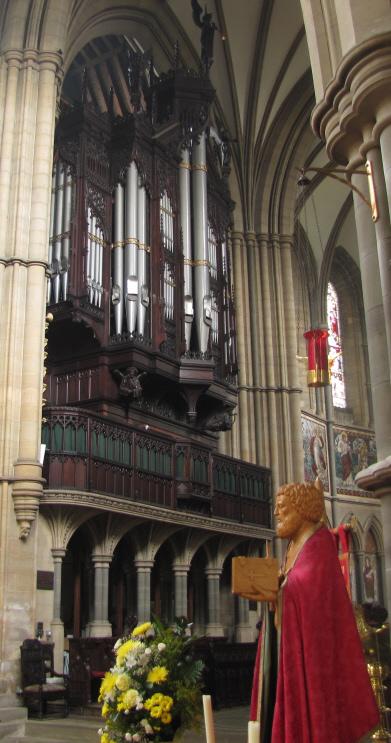
Standing at the entrance to the Chancel, next to the statue of St. Bartholmew, and looking up at the mighty Schulze organ.
Thanks to Graham Barber, the organist of St. Bartholomew's who oversees this prize, and the splendid work of David Butcher and Lavender Audio, all of us can now enjoy this monument of a bygone age.
And when you play it, and listen to the sound, perhaps from halfway down the church, you'll join me in saying, "The old Schulze can really roll it down the Nave!"
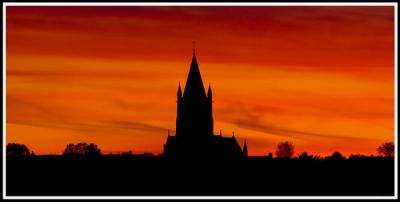
A dramatic view of St. Bartholomew's Church at sunset.
Comments